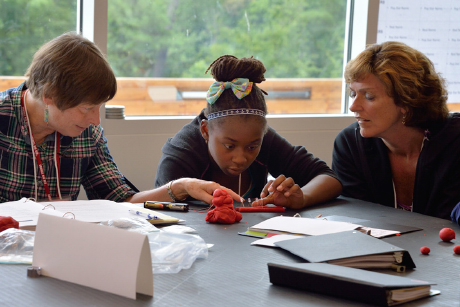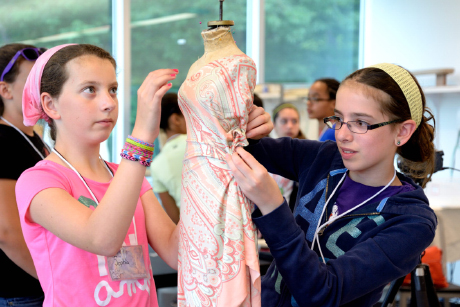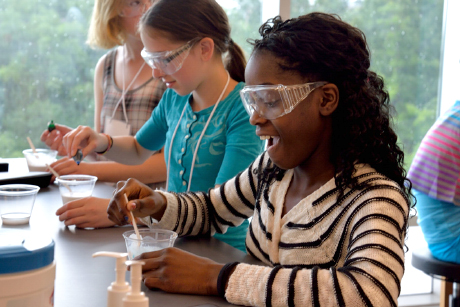Program stitches together STEM, fashion design
By Sara Birmingham



Inside Cornell’s Human Ecology Building, 33 middle school girls are using cloth, plastic, tape and assorted materials to build umbrellas. Rather than shield them from rain, though, these umbrellas are for an imaginary place where pond slime, grasshoppers, meteorites and other hazards fall from above.
This unusual challenge was part of a weeklong course, “Smart Clothing, Smart Girls: Engineering Through Apparel Design,” offered July 14-18 to engage teenage girls in STEM (science, technology, engineering and mathematics) fields, where women are often underrepresented. Now in its second year, the program, funded by the National Science Foundation, is led by Cornell’s Department of Fiber Science & Apparel Design (FSAD) in collaboration with the University of Minnesota, where associate professor Lucy Dunne ’02, M.A. ’04, leads a team. Cornell participants attended from 4-H programs in Livingston, Ontario and Wyoming counties and the Syracuse chapter of Girls Inc.
The umbrella lesson, said program leader Susan Ashdown, M.A. ’89, the Helen G. Canoyer Professor in FSAD, demonstrated that “there is a process to solving a design problem, and it is the same whether you are designing an umbrella, a car or a pop star’s outfit. For the entire week, the girls explored this process, as each activity directly relates to part of the design process and ultimately to their final challenge.”
Cornell researchers led girls through modules about mobility, electric circuitry for wearable technology, spatial perception in apparel design, and impact protection and insulation, with additional lessons on production and design development technologies used in the apparel industry.
“This year we had the girls explore garment shape and materials simultaneously as solutions to design challenges throughout the week,” said FSAD extension associate Fran Kozen ’72, M.S. ’77. “It was fun to see how well they understood the concepts and solutions presented this way.”
Each day was packed with hands-on activities. The girls created skirt patterns from measurements, constructed them using industrial machines and adorned them with LED lights. They experienced a virtual fitting, taking 3-D body scans and importing them into CAD software to digitally drape and manipulate pattern shapes on their avatars. Lindsay Aitchison, a NASA spacesuit engineer, teleconferenced with them.
For their final project, the students designed outfits for a hypothetical pop star’s performance on a faraway planet, with the challenge of protecting her from the harsh galactic climate while allowing her the freedom to move and dance.
“We did a test on LED lights to see how we could design them in our garments, and we’ve tested polymers for knee protection for impact,” said Grace Ebert, a ninth grade 4-Her from Ontario County, describing the singer’s apparel needs.
In their groups, the girls chose roles such as lighting technologist, pattern maker, stylist, reporter and material specialist to complete their project. At the end of the week, the budding designers and clothing engineers modeled their lighted skirts and displayed their prototype pop star garments at a fashion show attended by many of their parents.
“We ask a lot of them; we start activities at 9 a.m. and go until 5 p.m.,” said Kristen Morris ’15, a doctoral student in the field of apparel design. “Although we give them a lot of tasks and information in a short time, they come up with pretty incredible things in the end.”
Next year, the organizers plan to adapt the curriculum for use off campus, so that 4-H and Girls Inc. can offer interactive programming locally. They plan to produce teaching kits, a website and educational videos to supplement their current program.
Charlotte Coffman, FSAD senior extension associate, also helped develop and lead the program.
Sara Birmingham ’15 is a communications assistant for the College of Human Ecology.
Media Contact
Get Cornell news delivered right to your inbox.
Subscribe